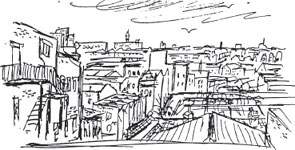While I am jotting down thoughts on drawing, I AM well aware that all who read them are at a different level of expertise. All I can do is pick my own brain and hope (sincerely, that is) that something will from time to time, pop up that you can incorporate into your psyche. Naturally, at this point, because the evening drawing class is almost my only contact with you, I base most of my criticism and analysis on what I observe in class. Some of you do not attend so there is no firsthand knowledge of either your problems or your skills. So I write on the assumption that drawing problems are at least partially universal. Even attitudes, in spite of that great verity individualism, are fairly universal. I am heartened by all that nebulous bit of assurance and move along. I am constantly encouraged by those who, week after week, comment on the handouts, remarking on how I had “hit home” on some problem.
I remember having very few brains to “pick” in my formative years. There was never anything as formal as a “handout.” Occasionally someone would say something that hit home. I would dash back to my room, write it down, and tack it on my desk, hoping that in persistently reading it, it would somehow seep into my thick skull and become a part of me.
One of my big problems was not knowing the right questions to ask (or being ashamed to ask them). If you don’t know something, even that it exists — what do you ask? How do you formulate a question about something you aren’t even aware of? Even then, everyone is not able to communicate or verbalize the things they know and do. Even when you find someone who is verbally equipped to pass on his know-how, not everyone is equipped to sort it out and put it to use. Perhaps they are not on the same wavelength or of compatible “chemistry.” A and B may be told something by C and afterwards A might have to explain to B the meaning of what C had said. Communication has a number of levels. A good teacher will be able to weave in and out of the possibilities of explaining something. I am reminded of the first radio my folks had.
It was a DeHoog crystal set. You had to move the point of a little wire around on a crystal to clarify the sound. That kind of adjustment between people is sometimes hard to manipulate.
Some people are “negative” by nature (or by upbringing or by self-choice) and so good chemistry is hard to come by. They may be wonderful people, desirous of learning and eager to do a good job, but often draw into a shell (of protection) because of repeated, non-productive attempts at communication.
Maybe it is because I was born in July, so being a “crab,” I attack things sideways and from all angles. (Have you ever watched a crab running away from you at the beach? They run sideways, as if trying to fool you into thinking they’re not really running in the direction they are running). One day, almost a half-century ago, during a discussion at coffee break, Hank Tanous, a very talented artist, said to me, “Walt, you’re not broadminded, you’re just wishy-washy.” Well, I like the idea of being “wishy-washy.” If I ever get “set in my ways,” I want it to be in a flexible, “wishy-washy” way. I think everyone should practice “wishy-washyness” at least to the degree that they remain persuadable. There are ideas to be picked up all around us all on different levels. We must be willing to “adjust the wire on the crystal” to get in tune with them.
Smugness and self-satisfaction have no place in an artist’s life. Not our kind of artists, anyway. Someday maybe you can retire and go to an attic and paint yourself into some narcissistic groove, but for now, everything should be OPERATION GATHER, with all levels of learning on GO.
RETRACTION DEPARTMENT Except this isn’t a retraction but rather an explanation of something in the last handout. I wrote on a page of Glen Keane’s drawings “Glen did these while walking.” That wasn’t really what I wanted to say about that page of drawings. I was in a hurry to wrap it all up and get it to the printer. Someone commented to me that they weren’t impressed with his having done them while walking — as if it were some “acrobatic fete.” I felt badly that it was taken that way, for what I really meant to say was that Glen is a relentless drawer, both in terms of learning and in practice. He’s extremely enthusiastic about drawing, to the point where if he is on a sketching trip, he’ll sketch out the window of a train or a hotel, or even sketch while walking. I admire that kind of attitude and devotion. I too am a walk-sketcher. While in England, I took some tours, and sketched all the way. We were approaching a castle once and I knew I wouldn’t have a chance to stop (they’d have left me behind) so I sketched as I walked. I’m not saying this is or isn’t a great sketch. That has nothing to do with it. What I’m saying is, the opportunity I had to sketch it was limited, but I made use of that opportunity. I’m proud of the sketch. I’m proud that I made it. I leave the judging of it to the “judges.”

I have also sketched while sitting on snow, on wet rocks, and in freezing wind. I have done water-color paintings standing in the cold wind and rain, holding an umbrella and a special drawing board I invented that strapped around my neck and leaned against my chest. (The spots on those paintings are real rain drops.) I never thought of them as “athletic fetes.” There were things to sketch and my time to do it was limited to those particular moments. I am an inveterate lover of the Canadian 7, and Emily Carr, who trudged into the Canadian wilderness to sketch and paint Canada. They braved snow, freezing weather, mosquitoes the size of sparrows in numbers that rivaled the stars in the Milky Way, also grizzly bears that were a constant menace, and other countless hardships. Why?
Because they had an irresistible urge to sketch and paint what to them was the real Canada. No one in any sane way could interpret their activities as an “acrobatic fete.” That was devotion to a cause that to me, is heroism, in all its glory. If you’re called you go, if you’re not called you stay home and prepare. You keep your crystal in good adjustment.
I was called to London to help out on the Roger Rabbit project. The first thing I did when I arrived in my office was to sketch the scene outside my window — the skyline of Camden Town:

Also, I sketched out the windows of buses, trains, and the underground trains:

If you’re an artist, you sketch period! Walk, run or fly, you sketch. Yes, I sketched out the window of the Delta flight to Orlando. Not because it was a fete but because it was an opportunity — you might say it was a necessity.
Incidentally, I admire people who keep on trying. There are a few people in the Tuesday and Wednesday class who are rank beginners. They come week after week and try and try and try. I pat them on the back not because they have made a Norman Rockwell-like drawing, but because there has been a little progress made. A lot of effort and a little progress. We may all be at different levels expertise-wise, but no matter what level we’re on, we deserve credit for trying.
Sure, somewhere along the line there has to be some professionalism or the product will suffer. That’s what these “handouts” are all about — to help in some small, large or whatever way. Me, I admire Glen for sketching while walking and I like the sketches, too. It was also suggested that if drawing while walking was such a special fete, maybe drawing while standing on one’s head would be even more commendable. I won’t argue with that. Betty Edwards, author of Drawing on The Right Side of The Brain (and other art teachers), have students draw the subjects upside down on their papers, and there seems to be some merit in that approach. I have beginners (and others) stop trying to draw, and let the pen do the work. Crazy? Perhaps, but it works wonders.
I don’t mean for this to sound like a rebuke or a rebuttal, in any sense of the word. I just saw an opportunity to help broaden your view of this whole problem of drawing. Like a crab — learn to approach it from different angles. And above all, keep adjusting the crystal.
Now for something a little more tangible. Here is a drawing of the model holding a basket with her left hand on one side and by the forearm (half way between the wrist and the elbow) on the other side. She is looking into the basket opening. My sketch shows how she would thrust her hips out to make a “shelf” for the basket. Also since she was tilting the basket so she could look into it, she would have to raise her right arm and push down with her left hand. The tilt (angle) of her shoulders makes a nice foil for the neck and face angles and opens up a nice “stage” where her look into the basket is emphasized. Can you see how thinking these things out before you start to draw will help in getting the story down in a clear manner? Notice how all the angles and the whole stance point to the look at the basket opening, which is the story of this pose.
That’s your critique for this week. Now here’s your inspirational drawing — a very, very, very nice drawing by Lureline Weatherly. On the Stanchfield scale of one to ten, ten being best, this is a ten plus.


